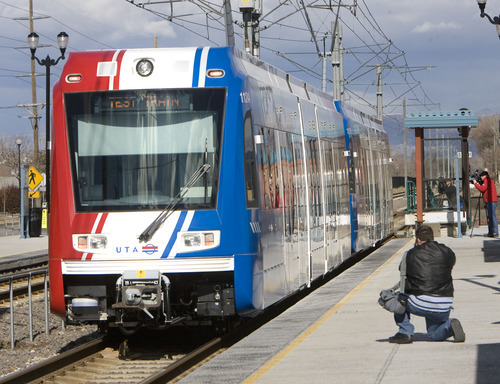This is an archived article that was published on sltrib.com in 2011, and information in the article may be outdated. It is provided only for personal research purposes and may not be reprinted.
Higher gasoline prices are again driving more people to take the bus or train.
As gasoline prices started spiking, the Utah Transit Authority saw an 8 percent jump in ridership in the past two months compared to the same period a year ago — from 6.03 million riders in January and February of 2010 to 6.51 million riders combined in those months this year.
Also, a new study released Monday by the American Public Transportation Association predicts that trend could add 15 percent more public transit riders nationally if gasoline prices hit $5 a gallon this year, and add 27 percent more if it hits $6 a gallon.
"Public transit is the quickest way for people to beat high gas prices if it is available," said APTA President William Millar.
In Utah, UTA spokesman Gerry Carpenter said that historically, UTA gains large numbers of riders every time that gasoline prices spike — but said about a three-month lag time usually occurs between when fuel starts rising and the peak of when large numbers of people switch to public transit.
"I don't claim to be an analyst. But it seems like people watch gasoline prices for a while. Once it seems like the gasoline hike is going to be here for a long time, they finally adjust life accordingly," he said.
For example, gasoline prices hit their all-time high in Utah — $4.18 a gallon for unleaded regular — on July 18, 2008. UTA hit its all-time record ridership three months later in September 2008 of 160,000 average weekday riders.
"We don't see an increase [in ridership] as much when gasoline prices inch up over time. But when there is a big jump — like 30 cents a gallon in a month — people say, 'Oh my gosh,' and make adjustments by starting to car pool, or telecommute or switch to public transit," Carpenter said.
Utah has been seeing such spikes recently. For example, AAA reported on Monday that the average price of unleaded gasoline in the Salt Lake metropolitan area was $3.38 a gallon, up from $3.31 a week ago, $3.05 a month ago and $2.83 from a year ago.
Carpenter said that when gasoline prices decrease, UTA ridership also drops — a little more quickly than when prices are rising, but still with a couple of months of lag time. He said overall UTA ridership usually remains higher, however, with some people apparently making the switch permanently to public transit.
Carpenter said it is difficult to say how much recent ridership increases are because of gasoline hikes, but says they are a factor. Others may include that Utah is starting to climb out of the recession, so more people are working and commuting — and traveling more.
He notes that recent ridership jumps are coming after fairly flat ridership growth last year — which was up 3 percent overall in 2010 compared to 2009.
APTA released projections on Monday saying based on increases it is seeing nationwide as gasoline prices rise, it figures that if gasoline hits $4 a gallon nationally, public transit ridership would increase about 7 percent — or an additional 670 million passenger trips per year to a total of 10.8 billion.
If gasoline hits $5 a gallon, it projects national ridership to increase 15 percent — or by 1.5 billion passenger trips to a total of 11.6 billion a year.
And if gasoline reaches $6 a gallon, it projects ridership to increase by 27 percent, or by 2.7 billion passenger trips to a total of 12.9 billion a year. —
Increasing transit ridership
Increase • 8.02 percent
2011
January • 3,311,515
February • 3,196,343
Two-month total • 6,507,858
2010
January • 2,958,567
February • 3,066,087
Two-month total • 6,024,654
Source: Utah Transit Authority





